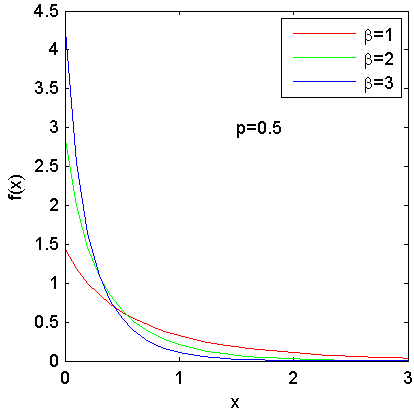| Template:Wikify is deprecated. Please use a more specific cleanup template as listed in the documentation. |
In probability theory and statistics, the Exponential-Logarithmic (EL) distribution
is a family of lifetime distribution with
decreasing failure rate, defined on the interval . This distribution is parameterized by two
parameters and .
[table of contents]
Introduction
The study of length of organisms, devices, materials, etc., is of major importance in the biological and engineering science. In general, life time of an device is expected to exhibit decreasing failure rate (DFR) when its behavior over time is characterized by 'work-hardening' (in engineering term) or 'immunity' (in biological term).
The Exponential-Logarithmic model together with its various properties are studied in Tahmasbi and Rezaei (2008)[1] This model is obtained under the concept of population heterogeneity (through the process of compounding).
Properties of the distribution
Distribution
The probability density function of EL distribution is monotone decreasing with modal value at .
For all values of parameters, the pdf is strictly decreasing in and tending to zero as . The EL leads to exponential distribution with parameter , as .
The distribution function is given by
and hence, the median is obtained by
.
Moments
The moment generating function of is determined from pdf by
direct integration and is given by
where is hypergeometric function. This function
is also known as Barnes's extended hypergeometric function. The
definition of is
where , is the number of
operands of , and is
the number of operands of . Generalized hypergeometric
function is quickly evaluated and readily available in standard
software such as Maple.
The moments of are determined from derivation of . For
, raw moments are given by
where is polylogarithm function and it is defined as
follows (Lewin, 1981) [2]:
Hence the mean and variance of the EL distribution
are given, respectively, by
The survival, hazard and mean residual life functions
The survival function (also known as reliability function) and hazard function (also known as failure rate function) of the EL distribution are given, respectively, by
The mean residual lifetime of the EL distribution is given by
where dilog is dilogarithm function defined as follows:
Random number generation
Let be a random variable from standard uniform distribution.
Then the following transformation of has EL distribution with
parameters and :
Estimation of the parameters
To estimate the parameters, EM algorithm is used. This method is discussed in Tahmasbi and Rezaei (2008). The EM iteration is given by












![{\displaystyle hypergeom_{2,1}([1,{\frac {\beta -t}{\beta }}],[{\frac {2\beta -t}{\beta }}],1-p)}](https://wikimedia.org/api/rest_v1/media/math/render/svg/9d043e16785fbdaa2d44a950895b7da41e6850df)